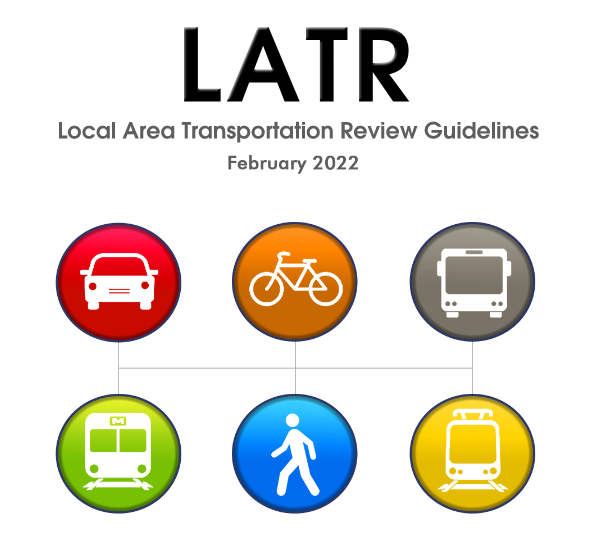Community invited to provide comment on proposed revisions to guidelines that implement the 2020-2024 Growth and Infrastructure Policy; changes focus on ensuring off-site improvements are proportional to a development’s impact on the county’s transportation systems

WHEATON, MD – The Montgomery County Planning Department, part of The Maryland-National Capital Park and Planning Commission (M-NCPPC), will present proposed revisions to the 2021 Local Area Transportation Review (LATR) Guidelines to the Planning Board at its February 17 virtual meeting. The LATR guidelines provide guidance to applicants and consultants on how to implement the transportation review process required by the 2020-2024 Growth and Infrastructure Policy (GIP). LATR is the process by which the adequacy of pedestrian, bicycle, bus transit and motor vehicle systems is evaluated near proposed new development sites. Depending on the circumstances, the process could require the developer to construct or pay for off-site improvements to ensure the transportation infrastructure meets adequacy and safety standards.
Montgomery Planning staff will present recommendations to the Montgomery County Planning Board to amend the LATR Guidelines to address concerns that the current version – adopted by the Planning Board in July 2021 – does not provide enough guidance related to the amount of transportation improvements required of a developer. In particular, the proposed changes will help ensure the cost of required pedestrian, bicycle and bus transit improvements are proportional to a development project’s impacts on the overall safety and functionality of the transportation system.
The proposed changes establish an LATR improvement cap that would apply to pedestrian, bicycle and bus transit improvements. The cap is set for each development project, as applicable, based on the extent of the development (number of residential units and/or commercial square footage), the project’s land use categories, and the applicable Non-Auto Driver Mode Share goal for the project’s location in the county.
Additionally, Planning Department staff is recommending other changes to the LATR Guidelines to:
- Update guidance on documenting deficiencies and proposed mitigation for the pedestrian, bicycle and bus transit system adequacy tests.
- Provide additional guidance on street lighting adequacy.
- Make additional minor edits and clarifications throughout the document.
View the staff report and proposed revisions to the 2021 LATR for the February 17 Planning Board meeting
The February 17 briefing with the Planning Board follows the October 21 Planning Board meeting on this topic where the Planning Board encouraged staff to analyze data and continue to meet with applicable stakeholders to refine the recommendations. View the October 21, 2021 Staff Report.
Provide testimony
The community is invited to provide testimony to the Planning Board at their virtual meeting on February 17, 2022 via Microsoft Teams. Community members are invited to sign up to testify or provide written comments by 12 p.m. on February 16.
About the LATR Guidelines
In July 2021, the Planning Board approved the LATR Guidelines, which articulate a methodology for documenting and analyzing the anticipated impacts of proposed development on pedestrian, bicycling, bus transit and motor vehicle travel in the County. The criteria in the LATR Guidelines determine whether a development can satisfy the requirements for transportation adequacy or whether offsite improvements are required to achieve adequacy. The criteria include the following adequacy tests:
- Motor Vehicle System Adequacy, using the Highway Capacity Manual assessment.
- Pedestrian System Adequacy, using the Pedestrian Level of Comfort, Street Lighting, and ADA Compliance assessments.
- Bicycle System Adequacy, using the Bicycle Level of Traffic Stress assessment.
- Bus Transit System Adequacy, using the Bus Shelter Availability Assessment.
About the Growth and Infrastructure Policy
The GIP ensures that development in Montgomery County is accompanied by appropriate and sufficient transportation facilities. The guidelines are used to estimate the impacts of development on the transportation network and determine effective ways to mitigate that impact.
The Growth and Infrastructure Policy (GIP) is a set of policy tools that guide the timely delivery of public facilities (schools, transportation, water, sewer, and other infrastructure) to serve existing and future development. These policy tools are the guidelines for the administration of the County’s Adequate Public Facilities Ordinance (APFO), and they are updated every four years by the County Council. The APFO directs the Montgomery County Planning Board to approve preliminary plans of subdivision, and other development applications or permits, only after finding that public facilities will be adequate to serve the subdivision or project. The most recent quadrennial update to the growth policy was adopted through Council Resolution 19-655 on November 16, 2020, which created the GIP.